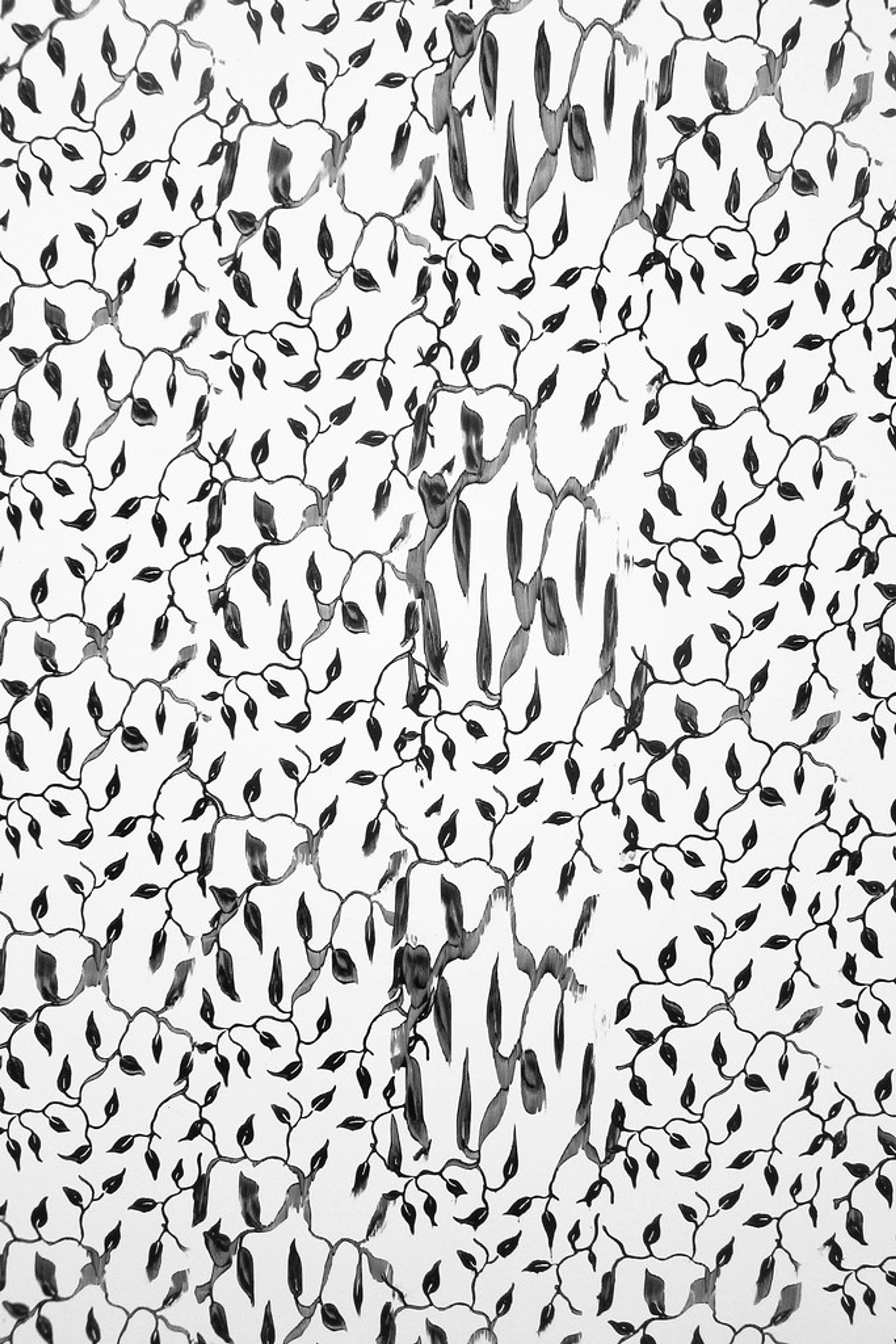
Christopher Wool: An Ultimate Guide to His Art, Life, and Influence
Explore the world of Christopher Wool, a pivotal figure in contemporary art. This guide delves into his life, distinctive artistic style, central themes like language and abstraction, notable works, market standing, and lasting legacy.
Christopher Wool: An Ultimate Guide to His Art, Life, and Influence
Okay, let's talk about Christopher Wool. If you've spent any time looking at contemporary art, you've probably seen those stark, bold text paintings that just grab you by the eyeballs. Or maybe the layered, almost messy abstractions that make you wonder, "How did he do that?" That's Christopher Wool, a figure who looms pretty large in the art world, constantly pushing and pulling at what painting is, what language does, and how we even make things in the first place. When I first encountered his work, especially those stark text paintings, I admit, part of me recoiled. Where was the expressive brushstroke? The narrative? It felt almost anti-art in a way, perhaps echoing the provocations of earlier movements like Dada or even the anti-aesthetic stance of some punk bands, yet utterly compelling. It challenged my very assumptions about what painting could be, and honestly, that's where the real conversation starts. He's left a serious mark on the late 20th and early 21st centuries, and honestly, diving into his work feels like trying to decode a brilliant, slightly chaotic message. This guide? Think of it as me walking you through his world, sharing what resonates with me as an artist and just a human trying to figure things out. We'll cover his life, that unmistakable style, the big ideas he grapples with, some key pieces, his undeniable market power (yep, his stuff costs a pretty penny!), and why he still matters so much today. Ready? Let's go.
Biography: Life, the City, and Finding Your Voice
Born in Chicago back in 1955, Christopher Wool made the move to New York City in the early 1970s. Now, imagine that – stepping into NYC at that time. It wasn't the polished place it is today; it was raw, electric, maybe a little dangerous, bursting with energy. Think punk rock, the 'No Wave' music scene with its confrontational, dissonant, and anti-commercial aesthetic – a real sense of DIY creativity and a healthy dose of rebellion, echoing the spirit of underground spaces like the East Village art scene of the 1980s. While he did a brief stint at the New York Studio School, I get the feeling his real education was soaking up that downtown environment. It reminds me of my own journey, where sometimes the most profound lessons come not from a textbook or a formal critique, but from the messy, exhilarating chaos of living and creating. Maybe it was the anonymous grit of the streets, the confrontational energy of the galleries, or the quiet focus he found amidst the chaos that truly molded his perspective. It shaped him, no doubt. You can almost feel that gritty energy, the layers of noise and visual information, the confrontational edge, seeping into his canvases later on. It makes you think, doesn't it, about how much our surroundings, the very air we breathe in our formative years, ends up on the canvas, whether we mean it to or not? It's a constant question for me in my own work – how much of the outside world gets pulled in?
Wool really hit his stride in the 1980s NYC art scene, right alongside artists who were grappling with big ideas like appropriation and bringing back expressive painting. After the austere nature of Minimalism and the intellectual rigor of Conceptual Art, a different kind of hunger emerged in the art world – a craving for rawness, immediacy, and critical engagement. Neo-Expressionism was bubbling, bringing back big gestures, but Wool sidestepped that, finding his own way to make painting feel urgent and relevant without relying on traditional emotionality. His work also emerged during a pivotal moment known as the Pictures Generation, where artists engaged with appropriation, media images, and the deconstruction of traditional forms. He wasn't just reacting to trends; he was carving out a space for a different kind of painting, one that was both detached and deeply felt. Critics and gallerists quickly took note. He's kept studios in New York City – still a key hub for contemporary art, and if you're ever there, checking out the Best Art Galleries in NYC is a must – and also out in Marfa, Texas. Marfa, another important spot on the US art cities map, offers a totally different vibe, vast and quiet, renowned for its large-scale minimalist installations, notably those by Donald Judd. I wonder how that contrast plays into his process? Major shows, like that big one at the Solomon R. Guggenheim Museum in 2013, have solidified his place as one of the most important artists of his time. It's a journey, isn't it? From soaking up the city's chaos to commanding museum walls.
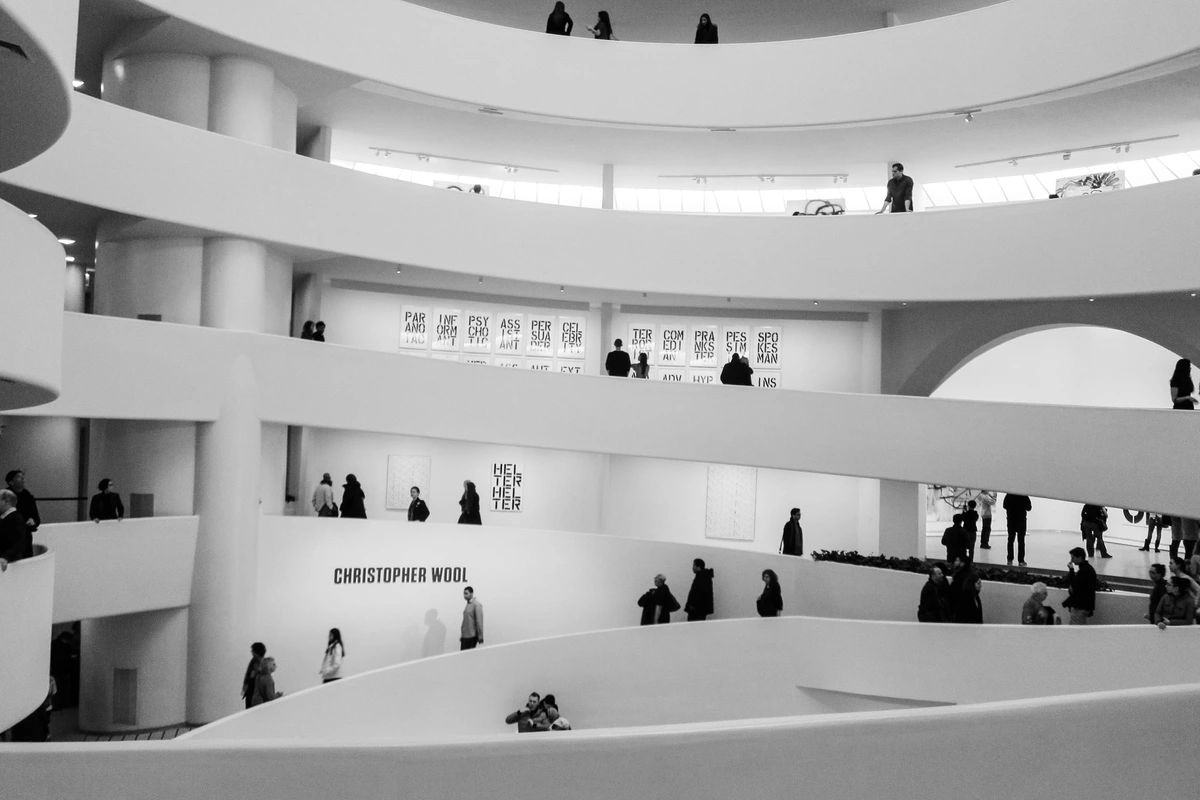
Artistic Style and Process: The Beautiful Mess of Making
At its heart, Wool's art, often on a commanding, monumental scale, is a deep dive into the process of making. He's constantly asking, "What is painting, really? What can it do, and what are its limits?" He uses tools you might find in a factory or a sign shop, deliberately sidestepping the traditional idea of the artist's expressive brushstroke. And honestly, as someone who spends a lot of time in the studio, wrestling with paint and ideas, there's something incredibly relatable about that struggle with process and control.
His approach to art-making was driven by a desire to push painting beyond the expressive gestures of Abstract Expressionism and the intellectual detachment of Conceptual Art. He sought a more objective, mechanical way to paint that still conveyed profound meaning. This quest led him to embrace tools of reproduction and a deliberate 'anti-aesthetic,' creating something undeniably powerful from unexpected means.

- Text Paintings: These are probably the ones you know best. Big, bold words or phrases, often broken up, stenciled onto surfaces like stark white aluminum or linen, usually in black enamel paint. They shout, they whisper, they challenge.
- Technique: He uses stencils and rollers, but here's the cool part – he lets the paint drip. He allows smudges. Letters break. He paints over things. It's not about perfect execution; it's about embracing the accidents, the imperfections that happen when a mechanical process meets a human hand (or a slightly messy roller). Isn't that just like life? The planned parts are fine, but the unexpected bits, the 'mistakes,' often become the most interesting. The way he spaces the letters, breaking words apart, makes you stop and look. You can't just read it; you have to see it. It forces you to confront language as a visual thing, not just a carrier of straightforward meaning. It's like the words are trying to escape their function of simply conveying a clear message, becoming something else entirely.
- Content: Where do the words come from? Films, music, stuff he hears on the street, cultural catchphrases. "SELL THE HOUSE SELL THE CAR SELL THE KIDS" – that one hits you, right? They can feel aggressive, nonsensical, or just plain sad. The fragmentation makes the meaning slippery, open to whatever you bring to it. It's ambiguous, and that ambiguity is powerful.
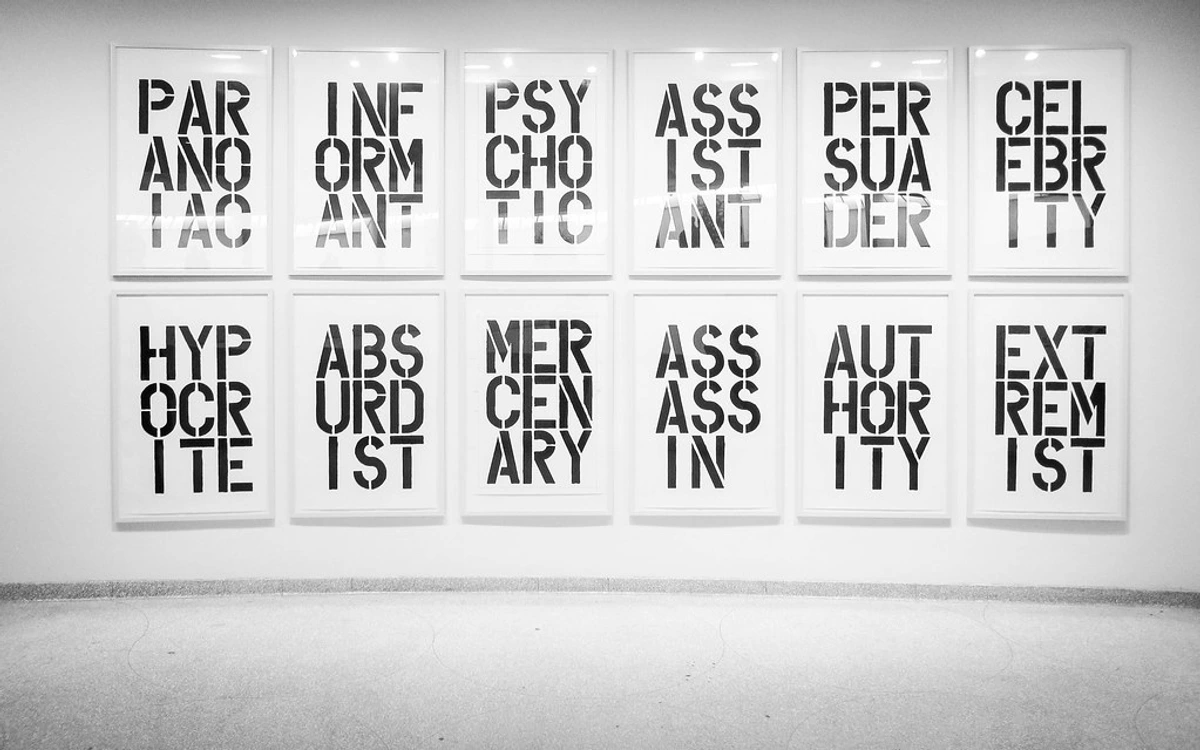
- Pattern Paintings: Starting in the late '80s, he used rollers with patterns, like you'd see on wallpaper – floral motifs, decorative swirls, abstract geometric designs. But again, he didn't aim for perfection. He'd let the rollers get clogged, slip, or overlap, creating layers of visual noise. The original pattern gets degraded, almost lost in the process. It's abstraction born from repetition and its breakdown. It makes you question decoration, control, and how meaning dissolves into form. It's a beautiful kind of visual static, a kind of elegant chaos, like when you find rhythm in unexpected places – perhaps in the hum of city traffic or the random patterns on a damp wall.
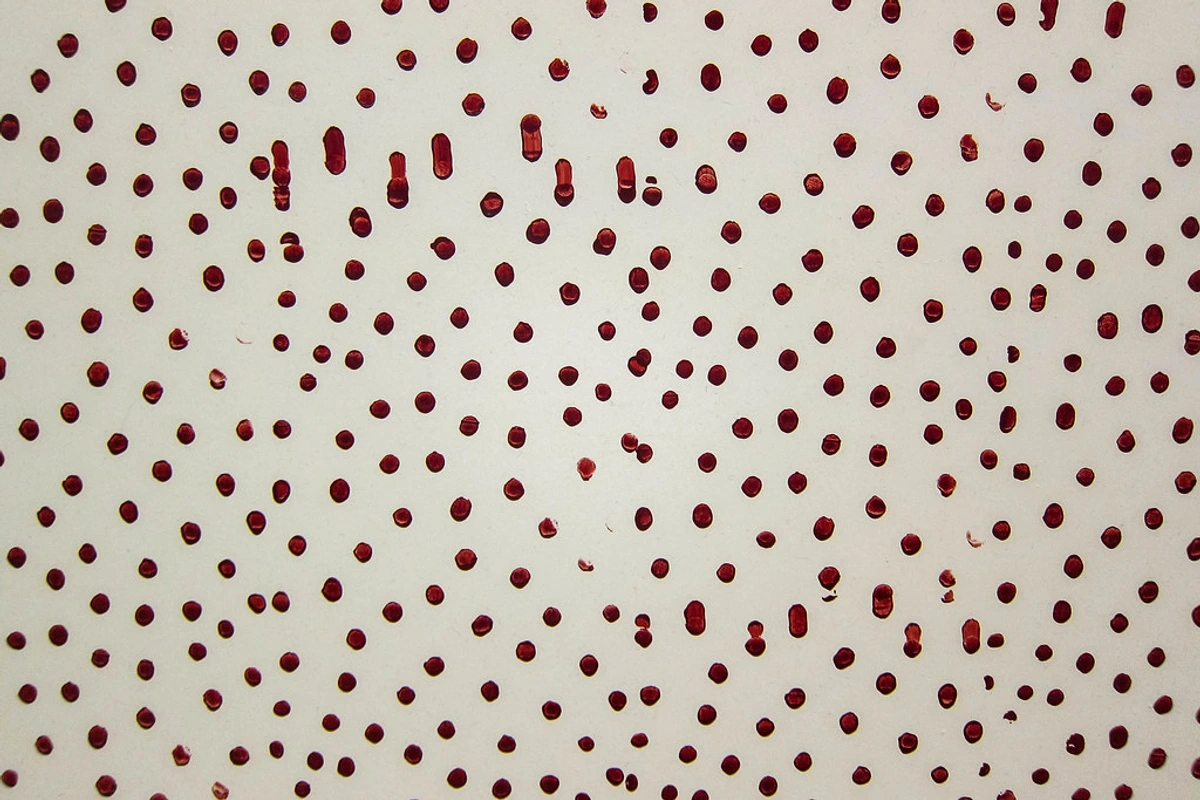
- Abstract / Gray Paintings: These came later, from the late '90s onwards. They're complex, often starting with images he'd made before, or even found images. He layers techniques – spray painting, silkscreening, wiping things away, painting over them. He even uses digital tools to mess with images before putting them back onto canvas with silkscreen. This deep engagement with silkscreening and incorporating digital manipulation highlights his interest in photography and printmaking as mediums that challenge traditional painting, blurring the lines between reproduction and unique creation. Layers build up, hiding and revealing bits of what's underneath. And erasure becomes a key move. Wiping away wet paint or ink isn't just cleaning up; it's an active part of the creation, a subtraction that adds something new. These works, often in limited colors or just shades of gray, are all about the surface, the history of marks, the push and pull between building up and tearing down. It's a process I understand deeply – sometimes the best way to move forward is to wipe the slate clean, or at least smudge it significantly.
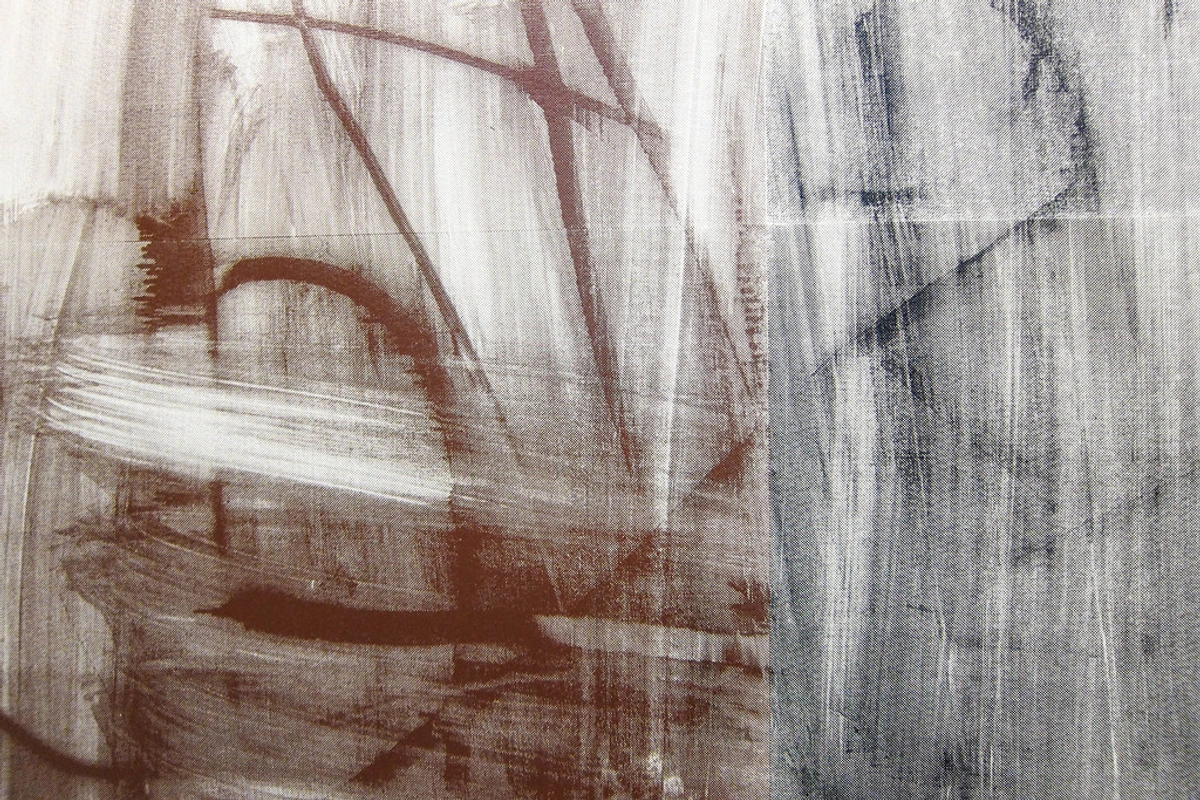
- Photographic Works and Artist Books: Beyond his paintings, Wool's engagement with photography and the creation of artist books are crucial aspects of his practice. His photographs often document his studio process, or gritty urban landscapes that echo his paintings' themes, further blurring the lines between different mediums. Similarly, his artist books, like "East Broadway Breakdown" (1994) or "Works" (2009), extend his visual language into reproducible formats, challenging notions of the unique art object and making his work accessible in new ways.
- Materials: Wool loves enamel paint. It gives his work that cool, flat, industrial look, like street signs or factory floors. It adds to that detached, almost mechanical feel, even when the process is messy. Enamel paint isn't your traditional oil or acrylic. It dries fast, often with a hard, glossy, or semi-glossy finish that looks industrial, almost detached. Because it dries quickly and doesn't blend smoothly, drips are sharper and surfaces flatter, emphasizing the mechanical process and the raw physicality of the paint itself. He also uses alkyd paints, which are similar in their fast-drying, durable properties, and Flashe, a vinyl paint known for its matte, opaque finish, and, of course, spray paint and silkscreen ink. Flashe's quick drying time and intense flatness make it ideal for the crisp, layered effects he seeks. These aren't just material choices; they're conceptual choices, reinforcing that sense of removal from the traditional artist's hand.
Central Themes: What's He Really Getting At?
Have you ever looked at a piece of art and felt it was trying to tell you something, even if you couldn't quite grasp the words? Or perhaps, as an artist yourself, questioned what your own work is truly trying to convey? When I look at Wool's work, these are the big ideas that keep coming back to me. They're not just academic concepts; they feel like things we all wrestle with, just amplified and made visible on his canvases. What deep currents does his art tap into?
- Language, Meaning, and Communication: This is huge. How do words work when they're just shapes? How does meaning get built, or fall apart? His fragmented text feels like the way we communicate sometimes – broken, ambiguous, open to misinterpretation. It makes you think about the power and the limits of language itself. As an artist, I often wonder if my own abstract marks are trying to 'speak' in a similar way, even without words.
- Abstraction and Representation: He plays right on the edge. Are those letters? Yes. But are they also just abstract forms, lines, and shapes? Absolutely. He blur's that line, showing how quickly something recognizable can dissolve into pure visual information, and vice versa. It's like a visual riddle that constantly asks: when does a word become just a brushstroke, and when does a splash of paint become a profound statement?
- Reproduction, Originality, and Appropriation: Using stencils, rollers, silkscreen – these are tools of mass production. By using them, he's questioning the whole idea of the unique, handmade masterpiece. He's borrowing from the world around him, recontextualizing it. This connects him to a longer lineage of appropriation art, seen in artists like Sherrie Levine or Richard Prince, who similarly challenged notions of authorship and originality by re-presenting existing imagery. Unlike many Pop Art artists, who often used silkscreen for direct, bright reproduction of popular images (think Andy Warhol and his soup cans), Wool's application of silkscreen often involves a deliberate process of degradation, layering, and erasure, leading to more abstract, process-focused, and less celebratory outcomes. His creation of artist books and editions further emphasizes this theme, presenting art in a reproducible, accessible format that challenges traditional notions of singularity. It makes you think: in a world saturated with images, what does 'originality' even mean anymore? Sometimes, I worry I’m just remixing other people’s ideas, then I remember that every artist, at some point, stands on the shoulders of giants – or maybe just messes around with their discarded paint rags. It's about what you do with it, isn't it?
- The Artist's Hand vs. Mechanical Reproduction: This is a pivotal tension in Wool's work. While traditionally painting celebrated the unique gesture and emotional imprint of the artist's hand, Wool deliberately introduces mechanical processes – stencils, rollers, silkscreen – that distance the artist from the mark-making. Yet, he simultaneously subverts these mechanical processes through drips, smudges, and intentional imperfections. It's a fascinating push-and-pull, highlighting the deliberate decision to embrace both control and chance, challenging the very definition of painterly authenticity and showing how profound expression can emerge from an embrace of the industrial and the imperfect.
- Urban Experience and Decay: That raw, layered, sometimes messy surface? It feels like the city, doesn't it? The visual clutter, the faded billboards, the peeling posters, the raw energy of graffiti, the way things get worn down and layered over time. His work seems to capture the energy and the entropy of the urban environment. It makes me wonder, how much of the city's pulse, its vibrant mess and subtle decay, do I let seep into my own canvases?
- Control vs. Chance: This is a thread running through all his work. He sets up a system – a stencil, a roller – but then actively invites or even engineers accidents. The drips, the smudges, the misalignments are not errors; they are essential parts of the piece. It’s a beautiful dance between intention and happenstance, an acknowledgment that sometimes, the most profound outcomes emerge from losing a little control. Doesn't that resonate with how we often find unexpected beauty or insight in the unplanned moments of our own lives, even when we try to meticulously plan everything?
- Painting and its Discontents: He's definitely in conversation with the history of painting, especially Abstract Expressionism. In the 1970s and 80s, there was a prevalent discussion about the 'death of painting' – that the medium had exhausted its possibilities. Wool's work, with its mechanical processes and critical engagement, effectively countered this, showing how painting could be re-energized by looking beyond its traditional confines. But he's also pushing back. He's subverting the idea of the heroic, expressive gesture by using mechanical means. It's like he's saying, "Okay, you guys did the big, emotional brushstrokes. I'm going to use a roller and see what happens." It's a critical, sometimes challenging, engagement with his own medium. Do I sometimes feel the urge to rebel against my own artistic habits too, just to see what happens? Sometimes, it feels like we, as artists, are always trying to put ourselves into neat little boxes for the critics, but the best work often defies easy categorization.
- Erasure and Negation: This one really resonates with me. The wiping, the painting over, the cancellation – these aren't just ways to fix mistakes. They're active creative forces. What's taken away is just as important as what's left behind. It's about the history embedded in the layers, the ghosts of what was there before. It's a powerful idea, not just in art, but in life – sometimes you have to erase to create space for something new. I often find myself doing this in my own studio – scrubbing away a layer, painting over a form, and finding that the unexpected 'negative space' suddenly clarifies the entire composition. It's a humbling lesson in letting go.
Influences and Context: Standing on the Shoulders of... Well, Everyone?
Wool didn't emerge from a vacuum. His work is in constant dialogue with what came before and what was happening around him. It's like he's sampling from history and culture, remixing it into his own unique sound. As someone who sometimes struggles to trace every single thread of influence in my own work, it’s fascinating to see how openly Wool engages with his artistic lineage.
- Art Historical: He's definitely wrestling with Abstract Expressionism (think the scale and energy of a Franz Kline or a Willem de Kooning), adopting their monumentality and their raw, direct impact, but intentionally subverting their emphasis on the artist's subjective, heroic gesture through his use of mechanical processes and detachment. Pop Art is clearly relevant with his use of silkscreen and borrowing from popular culture, recalling figures like Andy Warhol, but his tone is usually less celebratory, more questioning. You see echoes of Minimalism in his focus on process, industrial materials, and repetition. And Conceptual Art provides a framework for his deep engagement with language and ideas, echoing artists like Lawrence Weiner or Joseph Kosuth. This brings to mind artists like Robert Rauschenberg who famously integrated silkscreened photographic images into his paintings, though Wool's approach often feels more about process and degradation than direct narrative. It's a rich stew of influences, isn't it?
- Cultural: That NYC Downtown scene of the '70s and '80s – the raw energy, the punk attitude, the 'No Wave' sound, with its confrontational, dissonant, and DIY aesthetic – you can feel it in his work's edgy, deliberately imperfect, and sometimes aggressive tone. It's not about polish; it's about impact. The visual language of street art and graffiti, with its layers, tags, and bold text, is definitely in the mix; you can see parallels in the work of artists like Banksy. And even the stark, moody atmosphere of film noir has been mentioned as an influence, manifest in his often limited, stark palette and the sense of a hidden narrative or underlying tension in his fractured compositions. It's a reminder that artists don't just look at other art; they soak up the whole world around them.
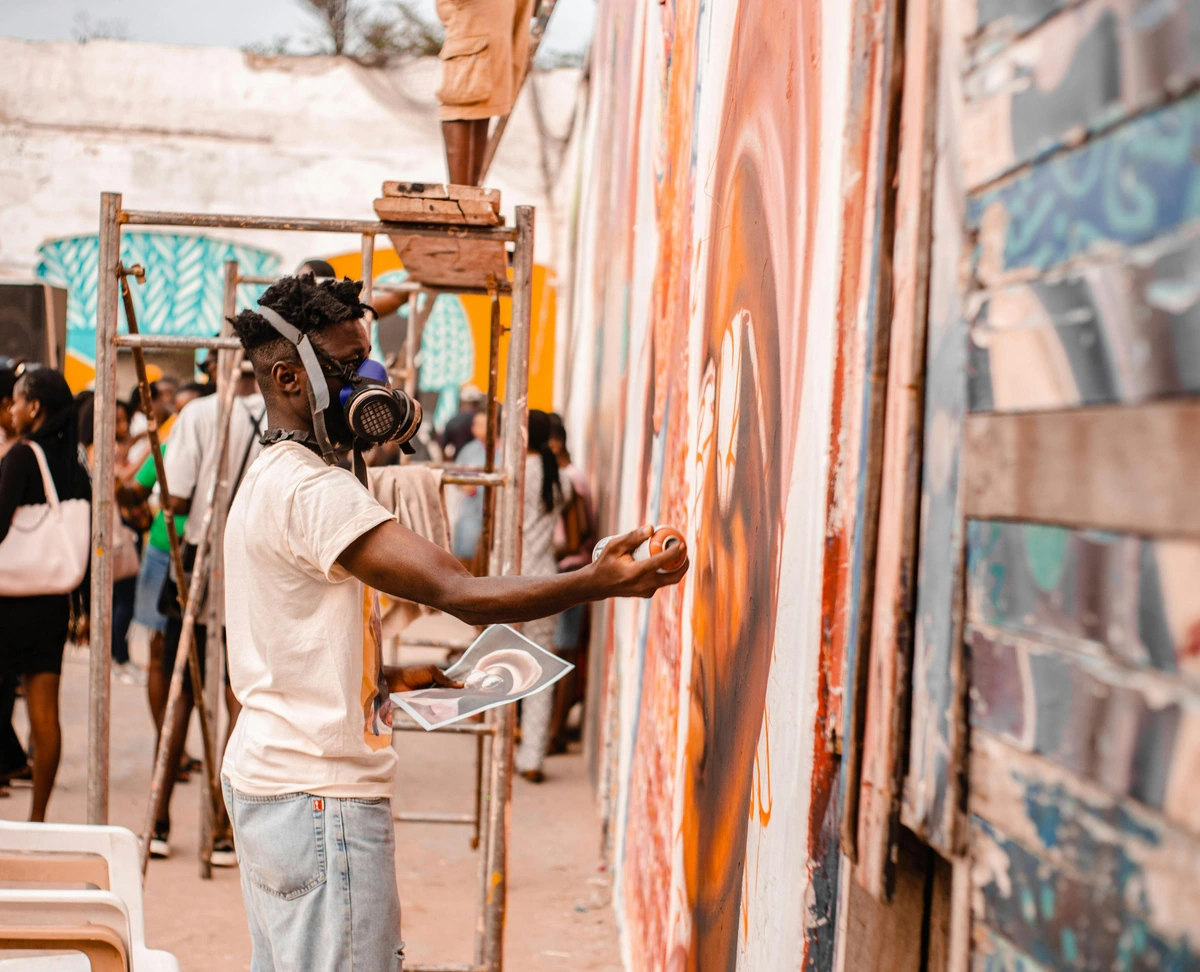
Analysis of Notable Works: Seeing the Ideas in Action
Looking at specific pieces really helps bring these ideas to life. While a table gives you the facts, let's talk about the feeling. So, what happens when we stand before these pieces? Try to imagine standing in front of these vast, commanding canvases, feeling the blunt force of their presence. They demand your attention, your questions.
Take Apocalypse Now (the "SELL THE HOUSE...") one. When you stand in front of that, knowing the text is a direct, chilling quote from the film Apocalypse Now, it's not just words. It's a command, a desperate plea, a reflection of societal pressure, all condensed into this blunt, fragmented visual. The drips and imperfections aren't flaws; they're part of the urgency, the breakdown. It hits you in the gut. Or Untitled (RIOT). Just one word, but loaded. Is it a description? A call to action? A state of mind? The stark black on white, the slightly messy stencil – it feels immediate, raw, maybe even a little dangerous. It's amazing how much power he packs into such simple elements.
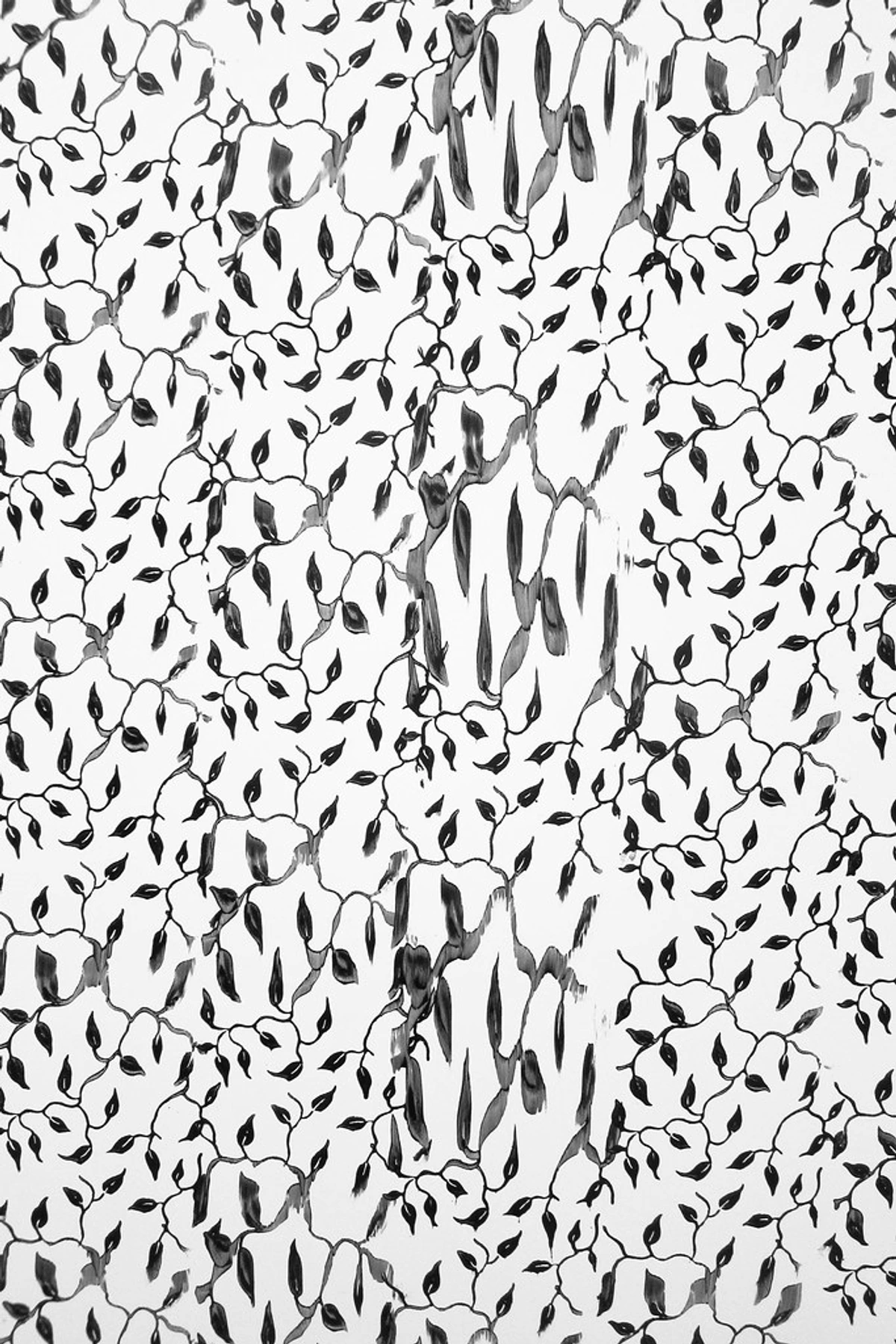
And what about those Pattern Paintings? Take one of his early ones, where a decorative floral motif is repeated, but the roller slips, clogs, smears, and the pattern dissolves into a beautiful, almost chaotic visual hum. Standing in front of it, you feel the tension between the intended order and the glorious breakdown of that order. It's like watching a precise machine fall apart in the most elegant way, revealing the inherent imperfections in any system. Imagine the faint ghost of a floral motif struggling to emerge from the smudged black ink, like a memory fading but still present. Or his later Abstract / Gray Paintings, such as Untitled (2009). These are dense, layered, almost archaeological surfaces. You see the ghosts of previous marks, the traces of silkscreened images, the assertive wipe marks that are not just corrections but deliberate acts of creation through negation. They feel weighty, meditative, like a visual record of a complex thought process, a constant building up and tearing down. It's that push and pull that fascinates me in my own work too – what stays, what goes, and what new thing emerges from the remnants? Sometimes, when I’m working on my own abstract pieces, I intentionally layer and then partially erase, seeking that same depth and history.
Work | Approx. Year | Medium | Significance |
|---|---|---|---|
| Apocalypse Now ("SELL THE HOUSE...") | 1988 | Alkyd and Flashe on aluminum | Iconic text painting; text sourced from the film Apocalypse Now; exemplifies fragmentation, confrontational tone, visual impact of language. |
| Untitled (RIOT) | 1990 | Enamel paint on aluminum | Single, powerful word; showcases stencil technique, drips, stark black and white contrast; ambiguous meaning (protest, disorder, humor?). |
| Representative Pattern Painting | c. 1989-95 | Enamel paint on aluminum/linen | Demonstrates use of rollers, layering, and degradation of patterns (e.g., floral motifs) into near abstraction; explores repetition/difference. |
| Untitled (2009) | 2009 | Silkscreen ink/enamel paint on linen | Exemplifies complex layering, use of silkscreen, spray paint, erasure; dense, complex surfaces suggesting creation through subtraction. |
These works aren't just things to look at; they're experiences. They force you to slow down, to question, to feel the tension between order and chaos, meaning and abstraction.
Market Standing and Critical Reception: The Price of Influence
So, you're probably wondering: why does this 'messy' art cost millions? Christopher Wool is, without question, a major player. He's seen as one of the most important American painters working today, right up there with the top living artists. And yeah, his works, especially those text paintings, command eye-watering prices at auction. For example, his iconic "Untitled" (1990), featuring the word "RIOT" in stark block letters, sold for a staggering $26.5 million at Sotheby's in 2015. We're talking multi-millions. It can feel a bit wild, can't it, when you think about paint on metal, especially when part of his aesthetic embraces the 'mess'? But the market value isn't just about the materials; it reflects his undeniable critical importance, his influence on other artists, and the high demand for his relatively limited output – often due to his meticulous, layered processes and the sheer scale of his works. Understanding the dynamics of art prices helps, but sometimes it still just feels like a different planet! His success has also been argued to have subtly shifted the art market, validating the value of process-oriented, conceptual painting in a way few other artists had previously achieved, challenging the focus on purely representational or traditionally expressive works.
His work has sparked tons of critical debate, which is exactly what important art should do. Some critics have debated the perceived "coolness" or emotional detachment of his work, while others have championed his radical re-envisioning of painting through mechanical means and appropriation. His engagement with pre-existing imagery and text has also fueled discussions around originality in an age of reproduction. He's a key figure in what's called 'post-conceptual painting,' which basically means painting that's deeply engaged with ideas and process, often questioning the very nature of art itself, rather than just focusing on the image. Think of it like a philosopher who happens to use a paintbrush instead of a pen – their primary output is ideas, and the painting is the vehicle for that thought.
Legacy and Influence: The Ripples He's Created
Wool's impact is huge. He didn't just make cool paintings; he changed the conversation. He profoundly influenced how artists think about using text and language in their work. He helped blur the lines between painting, printmaking, photography, and even digital art – showing that in the contemporary art world, it's less about the medium and more about the idea and the process. His work continues to resonate in discussions around the future of painting, even as artists experiment with digital mediums and AI, prompting questions about authorship and authentic mark-making. He legitimized using mechanical tools, appropriation, and embracing the mess as valid, powerful parts of a painting practice. His challenging visual language keeps pushing artists and viewers alike to think differently about what painting is and what it can be. He's opened doors for so many others, influencing a generation of painters like Mark Grotjahn with his exploration of repetition and process, or even younger artists engaging with text and abstraction in new ways. Seeing his work, I sometimes feel a little jolt of courage myself, a nudge to experiment with my own boundaries and embrace the unexpected in my artistic journey. Actually, it was after seeing a deep dive into his text paintings that I consciously started experimenting with incorporating fragmented symbols and almost-words into my own abstract compositions, something I’d never thought of before, truly opening up new avenues for my artistic expression.
Experiencing Christopher Wool's Art: Go See It!
Seriously, if you get the chance, go see his work in person. Photos don't do it justice. You need to stand in front of those big canvases and feel their presence. You'll see some people scratching their heads, others nodding knowingly, and a few just staring, mesmerized, trying to decode the visual riddle before them. His art is in major collections around the world – places like MoMA in New York, Tate Modern in London, the Art Institute of Chicago, and the Centre Pompidou in Paris. These are some of the best museums globally, known for their comprehensive collections of modern and contemporary art, making them prime locations to experience Wool's work firsthand! He's also represented by top international galleries like Luhring Augustine and Galerie Max Hetzler, where you might catch a solo show.
- How to Approach It (My Two Cents): I remember the first time I stood before one of his monumental text paintings – maybe it was 'FOOL' or 'RUN DOG RUN.' I expected to feel intellectual distance, but instead, the sheer physicality of the surface, the unexpected drips and smudges, pulled me in. It was like realizing a perfectly composed piece of music actually had a few intentional scratches on the vinyl – it made it more real, more human, and incredibly compelling. It challenged my neat categories of 'finished' versus 'unfinished,' and frankly, it was a little thrilling, like finding a secret message in a song you thought you knew. When you're standing there, don't just look for a pretty picture or a clear message. Lean in. Get close. Look at the surface. See the texture of the enamel, the drips, the places where he wiped paint away. What does that history of marks tell you? Think about the process. How did he make this? What does using a stencil or a roller, and then messing it up, suggest? Engage with the ambiguity. If it's a text painting, what do the fragmented words make you think or feel? If it's an abstraction, what does the layering and erasure evoke? Pay attention to the scale. How does the size of the painting affect you? Does it feel confrontational, overwhelming, or something else? It's a different way of looking than, say, appreciating the vibrant colors and expressive brushstrokes you might find in my own work, or the historical context you'd explore at a place like the Zen Museum in 's-Hertogenbosch. But experiencing this whole spectrum, maybe during visits to leading art cities, just deepens your appreciation for the incredible range of contemporary art.
Frequently Asked Questions (FAQ): Let's Chat About Wool
Okay, let's tackle some common questions, just like we're talking over coffee.
- What do Christopher Wool's text paintings mean? Ah, the million-dollar question! And honestly? There's no single answer. Wool picks words for how they look, how they sound, and the cultural baggage they carry. But by breaking them up and making them messy, he makes the meaning unstable. It's less about him telling you something specific and more about creating a space for you to find meaning, or maybe just feel the confusion or tension. They can be about power, communication breaking down, or just the noise of the city. What do you think they mean?
- What paint does Christopher Wool use? He's a big fan of enamel paint, often the industrial kind. It gives that signature flat, hard surface. He also uses spray paint and silkscreen ink. Not your typical artist's palette, right?
- Is Christopher Wool Pop Art? He definitely uses some tools and ideas from Pop Art, like silkscreen and borrowing from culture. But I wouldn't strictly call him Pop. While Pop Art often celebrates consumerism and popular imagery with a bright, sometimes ironic detachment, Wool’s focus feels more internal, more about the act of painting itself, abstraction, and the complexities of language, often with a darker, less shiny, and more critical feel than classic Pop Art artists like Andy Warhol. He's kind of his own thing, building on Pop but going somewhere else.
- Where does Christopher Wool get his words/phrases from? He's a collector of language! Quotes from movies (like Apocalypse Now, obviously!), books, song lyrics, things he overhears on the street, slang, political slogans. Sometimes, I suspect, he just picks words because he likes the way the letters look together. It's like found poetry, but visual.
- Why is Christopher Wool's art so valuable? It's a mix of things, isn't it? He's critically acclaimed and super influential – other artists look up to him. Museums and serious collectors want his work, and there isn't a huge amount of it out there. His place in art history is secure, and he has a proven track record at auction. It's the classic supply and demand, plus that intangible factor of being a truly significant artist. Still feels wild, though!
- Is Christopher Wool still working? Yep! He's still making art and exhibiting. He's not done challenging us yet.
Conclusion: What Wool Leaves Us With
So, where does that leave us with Christopher Wool? For me, he's a constant reminder that painting isn't dead; it's just evolving, shape-shifting, finding new ways to speak to us. Through his rigorous process, his iconic text pieces that get stuck in your head, and those complex, layered abstractions, he forces us to look harder, think deeper, and question everything we thought we knew about art. His work is cool, yes, maybe even a little detached on the surface, but it's also incredibly intense and deeply considered. It feels like a perfect reflection of our modern world – fragmented, layered, sometimes messy, and full of contradictory messages. He shows us the beauty in the breakdown, the meaning in the mess, and the power of taking things away. And as an artist, that idea – that erasure can be creation – is something I carry with me. He's a challenging voice, but an essential one. Go spend some time with his work. See what messages you find in the noise. He reminds us that sometimes, the loudest statements are made in a whisper, or a perfectly imperfect smudge.




